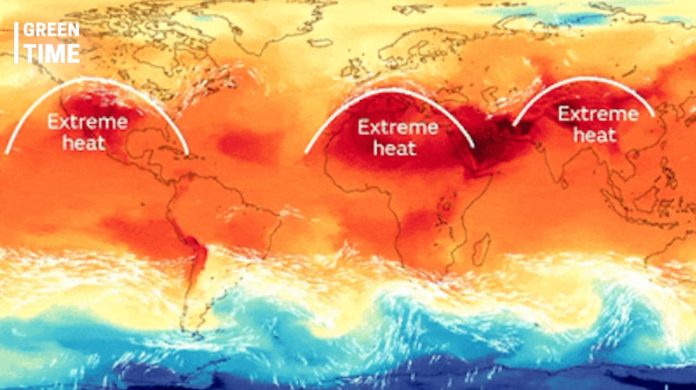The summer of 2024 was the hottest on record in the Northern Hemisphere. Heat waves were widespread, with Phoenix recording 100 degrees for over 100 days straight. In Europe, the 2024 Olympic Games started amidst a severe heat wave, including three of the hottest days on Earth, from July 21 to 23. According to the National Oceanic and Atmospheric Administration (NOAA), August was Earth’s hottest month in their 175-year record.
Globally, the average temperature was 2.74°F (1.52°C) above the 20th-century average.This seemingly small increase is driving more frequent and intense heat waves. Human-induced climate change underlies these changes and impacts weather patterns worldwide. In particular, a phenomenon called a heat dome played a key role in the extreme heat of 2024.
Understanding Heat Domes
A heat dome forms when high pressure sits over a large area. Air sinks under high pressure, warming up and reducing humidity, leading to clear skies. This high pressure acts like a lid, trapping warm air near the surface. As heat builds, the dome creates sweltering conditions for days or even weeks. The longer the dome lingers, the more extreme the heat becomes.
Heat domes were a major factor behind the intense heat waves in the summer of 2024. Their persistence depends on the behavior of the jet stream, a key player in shaping weather patterns.
How the Jet Stream Influences Heat Domes
The jet stream is a fast-moving band of winds high in the atmosphere, about 30,000 feet above sea level. These winds flow from west to east, driven by the temperature difference between warm tropical air and cold polar air. The jet stream does not move in a straight line; instead, it meanders in a wavy pattern, creating ridges and troughs.
When the jet stream forms a ridge, a high-pressure system develops south of the wave, creating conditions for heat domes. Conversely, when it forms a trough, a low-pressure system develops, bringing cooler air and storms. The position and behavior of the jet stream dictate how long a heat dome stays in place.
The Role of Climate Change in Jet Stream Behavior
Climate change is altering the behavior of the jet stream. The Arctic is warming about three times faster than the global average, a phenomenon known as Arctic amplification. As Arctic sea ice melts, more dark water is exposed, absorbing more sunlight and warming the region even faster. This reduces the temperature difference between the Arctic and the tropics, weakening the jet stream.
A slower jet stream meanders more, creating larger ridges and troughs. Larger ridges produce bigger high-pressure systems, while deeper troughs block them, causing the high pressure to stay in one place for longer periods. This stagnation leads to prolonged heat waves, as seen in 2024. The slow-moving jet stream allows heat domes to persist, intensifying heat waves across Europe, North America, and parts of Asia.
The Impact of Jet Stream Changes on Winter
The meandering jet stream doesn’t only affect summer weather. In winter, it can bring cold air from the polar vortex, leading to extreme cold events and severe winter storms. Just as in summer, the behavior of the jet stream is influenced by climate change, with long-lasting cold spells and harsh winter conditions becoming more common.
The Global Consequences of Heat Waves
The heat waves of 2024 were not isolated events. Simultaneous heat waves struck multiple regions, including Europe, Central Asia, and China. Prolonged exposure to extreme heat has serious consequences for human health, agriculture, and ecosystems. Crops suffer, water sources deplete, and the risk of wildfires increases, affecting millions of people worldwide.
The record-breaking heat waves of 2024 are a stark reminder of the impacts of human-caused climate change. As the jet stream’s behavior changes and heat domes become more frequent, the need for climate action becomes more urgent. Without efforts to reduce greenhouse gas emissions and mitigate global warming, extreme weather events will continue to intensify, with severe consequences for people and the planet.
In summary, the combination of heat domes, a slower jet stream, and climate change created the perfect storm for the record-breaking summer of 2024. As temperatures rise and weather patterns shift, the world must take action to protect communities from the growing threat of extreme heat.

